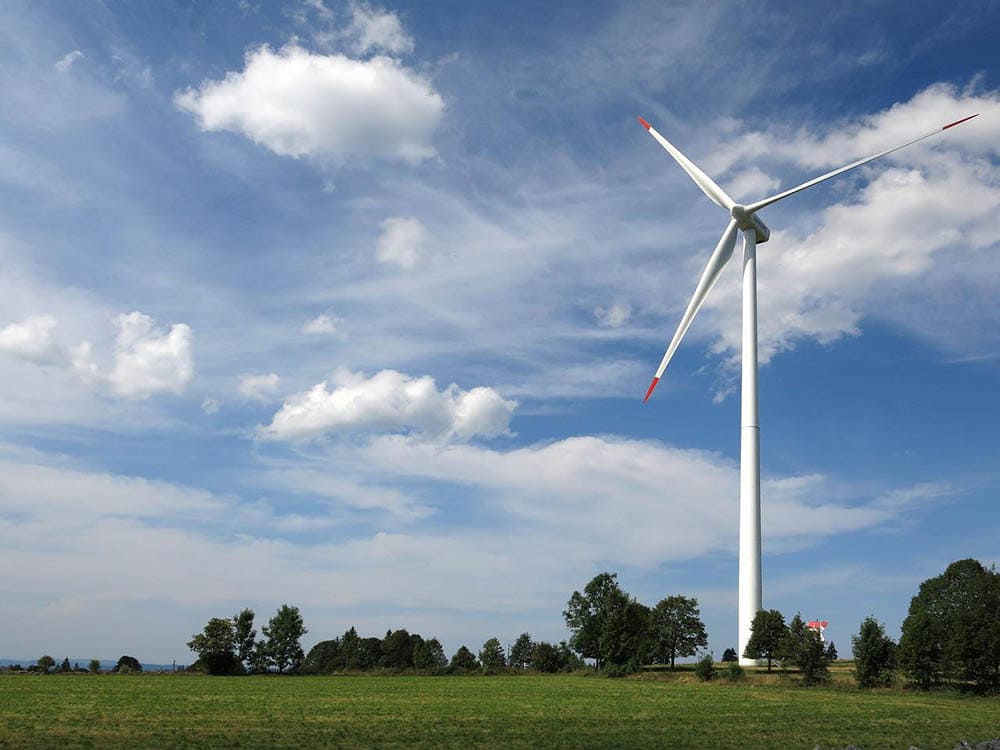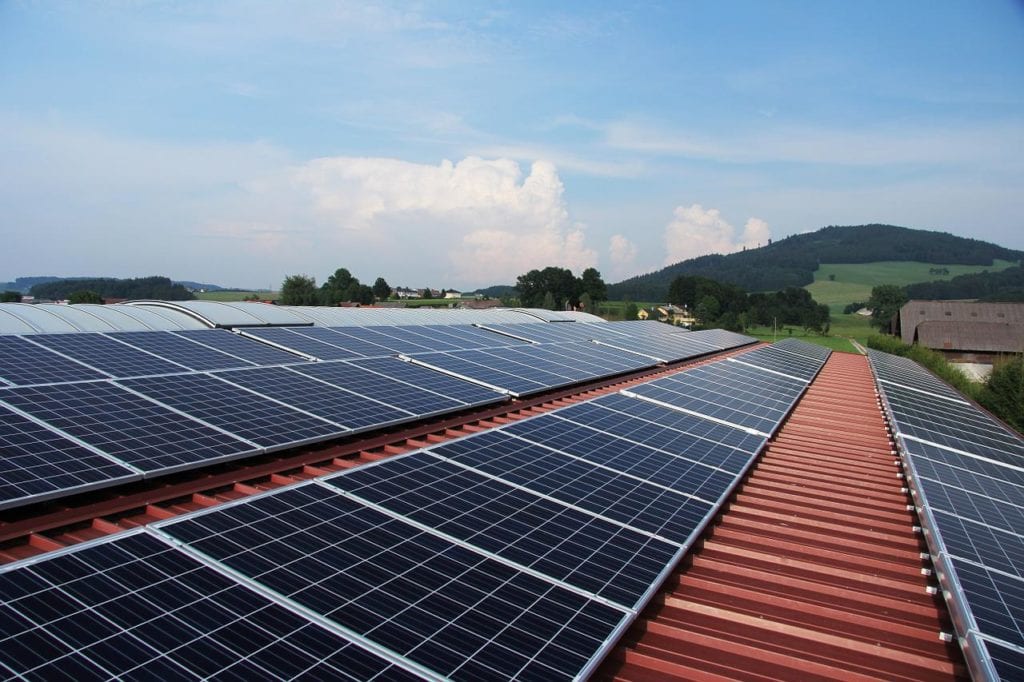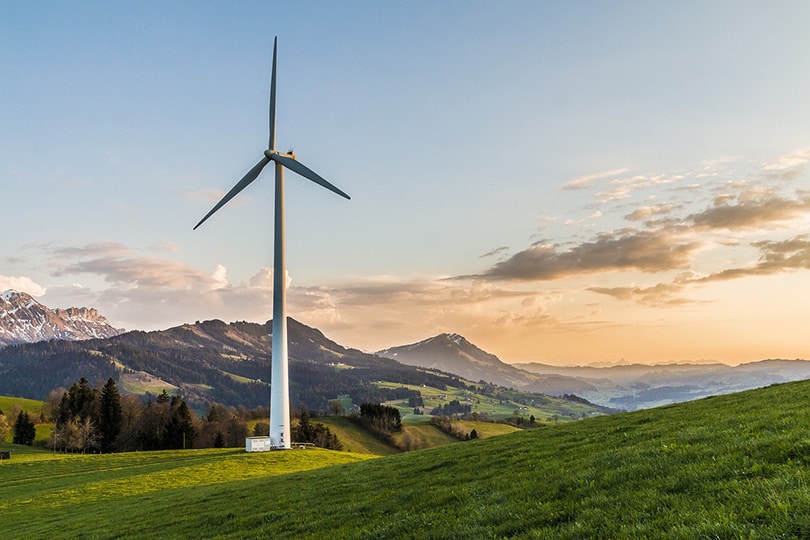Renewable Energy in the UK: Percentage & Production Rates
-
Pete Ortiz
- Last updated:

More countries around the world have stated their aims to increase renewable energy production and minimize their dependence on fossil fuels.
The UK’s climate and its position as an island mean that it has substantial potential for wind generation, which currently accounts for approximately half of the country’s renewable energy.
However, solar power has seen a substantial increase in the past couple of years, especially in the shape of rooftop on-site photovoltaic (PV) installations, and the government recently announced plans to expand current nuclear power operations while also opening new nuclear power plants.
The government has stated its intention to produce 100% of its power from renewable sources by 2035, with renewables currently making up 43.5% of power generation.
Below, you will find 14 facts about renewable energy production in the UK, including a look at the types of renewable currently deployed.
14 UK Statistics About Renewable Energy in the UK
- Energy consumption in the UK was down 8% in 2021 compared to 2019.
- 121.9 terawatt-hours (TWh) of renewable energy was produced in 2021.
- Renewable energy is responsible for approximately one-third of the country’s power output.
- Bioenergy is the UK’s second greatest source of renewable power.
- The UK wants to produce 100% of its power from renewable sources by 2035.
- The UK is expected to produce 56% of its total power from renewables and nuclear by 2026.
- Nuclear power accounted for 16% of total power in 2020.
- There are over 1 million solar PV sites in the UK.
- Cornwall has the highest number of PV sites in the country.
- Solar power accounts for 6.8% of the UK’s renewable energy.
- The UK now has 14.6 gigawatts (GW) of solar power capacity.
- 369 megawatts (MW) of on-site rooftop solar panels were installed in 2021.
- Almost 50% of the UK’s renewable energy comes from wind power.
- Wind energy production dropped 14% in 2021 compared to 2020.
UK Renewable Energy Figures
1. Energy consumption in the UK was down 8% in 2021 compared to 2019 (Gov.uk Energy Trends Report)
The Coronavirus pandemic saw the world undergo significant changes. Lockdowns meant that people were encouraged to work from home, and many shops and other venues were closed throughout the pandemic. As a result of this, energy consumption dropped significantly in most countries. So, the UK consumed 8% less energy in 2021 than it did in 2019 before the pandemic hit. Consumption remained low in the first few months of the year as many restrictions were still in place, but those figures increased from around April when the majority of restrictions were lifted.
2. 121.9 terawatt hours (TWh) of renewable energy was produced in 2021. (Gov.uk Energy Trends Report)
A total of 121.9 TWh of renewable energy was produced in the UK in 2021. This is 9.5% lower than in 2020, led by lower average wind speeds and the closure of the Dungeness B nuclear power plant in June 2021. Bioenergy was the only renewable technology that saw an increase in output, rising 1.8% to produce 40 TWh of power in the year.
3. Renewable energy is responsible for approximately one-third of the country’s power output. (Statista 1)
As well as renewables, the UK also produces energy from non-renewable sources and imports power from other countries. In total, approximately one-third of the country’s power output, or the amount of power that is used, comes from renewable sources, including wind power, solar, and nuclear power.
4. Bioenergy is the UK’s second greatest source of renewable power. (Statista 1)
When it comes to the types of renewable energy in the UK, wind power is the most productive and yields approximately 50% of all renewable energy produced. The second biggest source of renewables is bioenergy.
Biomass fuel is wood or other plant-based fuels that are used to produce electricity or to produce heat. While wind power produced 32 TWh of power, bioenergy only produced 39,000 gigawatt hours (GWh) of power. Solar was the next biggest source of renewable energy and produced 13.6 GWh.
5. The UK wants to produce 100% of its power from renewable sources by 2035. (SPGlobal)
Following significant increases in gas prices in 2021, the UK government said that it could produce all power from renewable sources by 2035. Following sanctions placed on Russia and a lack of supply from Ukraine in 2022, the need to move away from exported power and towards renewables has arguably been even more important.

6. The UK is expected to produce 56% of its total power from renewables and nuclear by 2026. (SPGlobal)
The UK is expected to produce 56% of its total power output from renewables plus nuclear power. The government recently announced that it planned to increase nuclear capacity from 7 GW to 24 GW while also stating that solar production would increase from 14 GW to 70 GW by 2035, and offshore wind projects would be ramped up to provide an additional 40 GW from current figures.
7. Nuclear power accounted for 16% of total power in 2020. (SPGlobal)
Although nuclear power tends to be divisive, it is seen by some as a cleaner form of energy because the power-producing material is highly dense, and it is considered a reliable energy source. It also has a relatively small land footprint. The UK currently has 13 nuclear reactors over six sites. While the country had been scaling nuclear power down, it still accounted for 16% of total power production in the UK in 2020.
Solar
8. There are over 1 million solar PV sites in the UK. (Statista 2)
The UK has an average of 4.6 hours of sunlight per day, and while it does not have as sunny a climate as many other countries, there is still potential for an increase in solar power production. Grants once offered by the government to install PV tiles on home roofs are no longer available, but the country has continued to see an increase in the number of solar sites. There are now more than 1 million such sites in the UK.
9. Cornwall has the highest number of PV sites in the country.(Stelrad)
Cornwall, in the South of England, has the most solar PV sites of any county in the country. There are just over 18,000 solar PV sites which include home installations and those connected to the power grid. It is likely that solar is most popular in Cornwall because, along with neighboring county Devon, it is the county that has the highest levels of daylight hours and sun per year.

10. Solar power accounts for 6.8% of the UK’s renewable energy.(TheEcoExperts)
Solar power installations are on the increase in the UK, but it still falls some way behind other renewable sources like wind and biomass fuel. Only 6.8% of the country’s renewable energy currently comes from solar power.
11. The UK now has 14.6 GW of solar power capacity.(SolarEnergyUK)
An additional 5.3% of solar energy was produced in the UK in 2021, showing that it is on the increase. This means that 14.6 GW of power is produced using the sun. This includes residential rooftops, commercial-scale installations, and ground-mounted solar PV sites.
12. 369 megawatts (MW) of on-site rooftop solar panels were installed in 2021. (SolarEnergyUK)
The year 2015 saw the most rooftop solar panels installed in the UK when more than 800 MW of capacity was added. However, at this time, there were government grants and subsidies available for homeowners that wished to install the tiles. These grants are no longer available, but 2021 still saw 369 MW of capacity added, which is the highest amount when subsidies have not been available.
Wind Power
13. Almost 50% of the UK’s renewable energy comes from wind power. (Statista 1)
The UK may not have as much sunlight or sun hours as other countries in the world, but it does have a lot of wind, both inland and out at sea. As a result of this, the country generates a lot of renewable energy using wind power. Approximately half of the country’s renewable energy is produced from onshore and offshore wind farms, with more planned in the future.

14. Wind energy production dropped 14% in 2021 compared to 2020. (Gov.uk Energy Trends Report)
Although the UK’s renewable energy sector is dependent on wind power, wind energy production actually dropped by 14% in 2021 compared to 2020. Much of this decline can be attributed to the fact that average wind speeds were lower in the 12 months compared to the 12 months prior.
Frequently Asked Questions
What Is the Main Renewable Energy Source in the UK?
The UK generates approximately half of all its renewable energy using wind power. This includes onshore and offshore wind farms. The second biggest contributor to renewable energy is biomass. An increasing amount of power is being generated from solar panels and installations, and there are plans to increase nuclear power generation in the coming years.
Is the UK Good for Renewable Energy?
Although there is always room for improvement and an increase in capacity, the UK’s renewable energy production outstripped fossil fuel generation for the first time in 2020. During the year, 42% of the country’s electricity was generated from renewable sources, with 41% coming from fossil fuels and the remaining power being imported from overseas. (Ember)

Where Does the UK Get Its Power From?
The UK produces power from a range of sources, with around a quarter coming from wind, solar, and hydroelectric power. Nuclear accounts for 12% of power production and coal only 1%. The UK also imports energy from a number of countries.
Does the UK Produce Its Own Gas?
The UK does produce its own gas, but the amount produced has been steadily declining in recent years. Now, more than half of the country’s gas is imported. Approximately 47% of the gas used in the UK is imported from Norway, Netherlands, Belgium, and Russia. Another 9% is imported as liquid natural gas from Qatar. (National World)
Conclusion
Most countries are pushing towards greater renewable energy output in a bid to protect the environment. However, more recently, they have tried to avoid buying any important power from Russia. The UK now produces more electricity from renewable sources than from fossil fuels and aims to produce 100% of all its power from renewable sources by 2035.
Featured Image Credit: b1-foto, Pixabay
Contents





